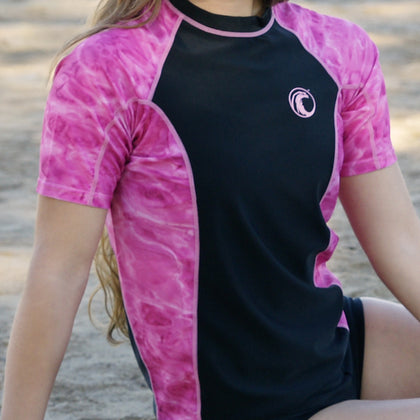Size Charts











With your bag casually slung over one shoulder and your board under one arm, you stroll down to your car, load up for the day, and head off surfing. There’s no better way to spend the day really!
Surfing’s pretty simple when it comes to surfing gear. You’ve got your surfboard, of course, your boardies, your wetsuit, and your trusty rash guard.
But funnily enough, no matter how much of a seasoned surfer you may be, there are still some surfers who struggle to find the right fit when it comes to their rash guard, so what’s the trick?
It’s important to remember that like anything, rash guards come in a variety of different sizes, styles, fabrics, and even thicknesses – it all really depends on their purpose.
Rash guards are not only used for surfing; they’re also used for many other popular ocean sports…but at the end of the day, surfing remains the number one water sport in many countries.
There a few different purposes of a rash guard with the main ones being they offer warmth in the cool waters, sun protection, jellyfish protection, and of course rash protection, hence the name, rash guard; because surfers tend to lay flat and paddle more than they stand, and this constant movement causes friction, which can often result in skin rashes.
You can choose how to wear a rash guard. You might choose it to wear it under your wetsuit for additional warmth or rash protection, or you might choose to wear it alone when the weather is more favorable.
If you’re looking for a rash guard to fit you and your purposes, follow these six rash guard tips to ensure you remain protected and look the part in the water at the same time!
1. The Fit – Size Does Matter
Generally speaking, there are two different rash guard fits – skin-tight or loose-fit. Choosing the right rash guard fit has nothing to do with your body shape or what it will look like on, it’s all related to what you will use the rash guard for.
If you love water sports and are heading off for a bit of surfing, diving or swimming, a skin-tight rash guard that has a snugger fit is better. The rash guard will move with your body, and there will be no excess fabric getting in the way. Skin-tight rash guards also offer you less resistance when you’re in the water, which will make it much easier for you to do your chosen water sport.
On the other hand, if you’re planning on having a chilled out day on your boat or on the beach and you’re looking for more sun protection, a looser fitting rash guard will be more comfortable and probably suit your needs better, as long as it comes with a UPF50+ sun protection rating.
2. The Style – It Also Matters!
Just like all your favorite pieces of clothing, rash guards come in a variety of styles. They’re readily available in short and long sleeves. Choosing the style of your rash guard often depends on where you live and the climate. If you live in an area that’s hotter, long-sleeved rash guards with UPF50+ will protect you more than a short-sleeved rash guard. But, remember you’ll definitely feel the heat more with a tight-fit long-sleeved rash guard unless of course, you’re constantly moving in and out of the water.
Short-sleeved rash guards protect the more delicate areas of the body from the sun such as the back of the neck, chest, and back while allowing you to remain a bit cooler in hotter climes.
Different prints and colors on the rash guard will personalize your rash guard, and make you look amazing. For unique rash guards with water-inspired prints, Aqua Design has a number of stylish and sporty options to choose from. You will not only remain protected but have a water-inspired appearance on the beach and in the water as well.
3. The Fabric – How Does It Feel?
Today, there are a number of rash guards on the market, and of course, they all differ in quality. Only buy rash guards made out of UPF50+ fabric. A fabric can be UPF50+ in two ways – it can either be treated or it could have been knit into the fabric itself during the production process.
Rash guards are made of a blend of synthetic fibers. This includes spandex, which is stretchy, and polyester, which allows for breathability. Look for a rash guard made from a combination of polyester or nylon with elastane, as it has all of the above qualities, and it’s also quick drying!
4. How Fast Does It Dry?
When you look for a new rash guard, you’ve got to also consider how long it takes to dry – this, of course, makes sense considering that most people use rash guards for water activities and sports. It’s essential the fabric will dry quickly, so it won’t affect your body temperature.
5. Stitches – Look At The Smaller Details
If you’re going to use your rash guard for active sports, such as surfing, look for rash guards that have flat-locked seams to minimize any chafing.
6. The Added-Extras
One of the most vulnerable parts of your body to the sun is the back of the neck, this is especially so as most people forget to put sunscreen on here. Look for a rash guard with a mock or high collar that will ensure this area is well covered.
It doesn’t matter if you’re the person who carves up the waves on a daily basis, a casual surfer, or someone who prefers to relax on their boat, there’s a quality rash guard out there for your purpose. For a wide selection of multi-purpose rash guards for men and women and all your other beach and active wear needs, visit Aqua Design.
The perfect wave and rash guard are out there – go find them!



Have you wondered what a rash guard is and why women wear them? This article explains what they are and why they are so important.









